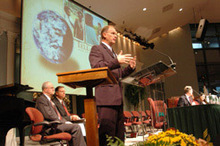March 8, 2006 Silver Spring, Maryland, United States …. [Wendi Rogers/ANN]
Since adopting Tell the World as a vision for the Seventh-day Adventist world church, many stories have been told. People around the world are voicing their stories of hope, of love, and of motivation — even of overcoming their fears.
Some — perhaps many — may be afraid of the word “witness.” Mike Ryan, a general vice president of the world church and one of the architects of Tell the World, says that at a meeting last summer he made an appeal for people to become involved in mission. After he spoke, “a lady came up and said, ‘I have always been afraid to go out and contact any of my neighbors. But today the Holy Spirit has really made me determined that I want to do this. I really want to go out and try to win one person. Surely I can do that in the next five years.'”
Ryan says he didn’t think too much about it, “other than, ‘I’m glad you’re inspired.'”
But four months later he later received a letter from that woman. She wrote, “I envisioned that I would probably spend a year training myself. Then I would spend a year where I would just sort of try to get to some niche — work on my strategy. I want you to know that I already have one person that has been baptized and that I’ve taken through the entire series of Bible studies. And she is now a practicing Seventh-day Adventist.’
“That’s the whole point. Find somebody. Everybody knows somebody,” says Ryan.
Tell the World has seven areas of emphasis: spiritual growth, community involvement, personal witness, city outreach, church planting, evangelistic programming, and media ministry.
“It’s been a rallying call that’s brought people into … alignment with the mission of the church. It is important that we align our resources to address a direction that the world church has said we’re going.”
Ryan has heard people say that an emphasis like this from the world church is long overdue. “I think a lot of people sense that the direction that we’re going is the right [one]. For example, the Bible study and prayer [emphasis]: I think if we could accomplish that one thing alone, you wouldn’t have to have the other six, because you’d have more people reading and praying and they would be more in tune with the culture of mission that we have in this church.”
Rick Kajiura, communication director for the Office of Mission Awareness, says, “One of the immediate goals is to get people praying and spending more time studying their Bibles. We’d like them to prayerfully consider what they can do to help ‘Tell the World’ about Jesus. One of the things we’re asking is for Adventists to prayerfully consider dedicating 2 percent of their income to supporting mission work through the mission offerings collected in their local church each week.”
He adds that in 1930, Adventists were giving 6 percent of their income to support mission, but today they are only giving less than one-half of 1 percent.
They are hoping, Ryan explains, to raise the percentage of Adventists who are praying and reading the Bible from approximately 49 percent to at least 65 percent. With this renewed emphasis on mission, the church is planning to plant 20,000 new church congregations worldwide, implement a complete evangelism strategy in 27 major cities worldwide, initiate 400,000 outreach meetings, and encourage 5 million Adventists to reach one person in the next five years.
All part of Tell the World, these goals represent a great challenge for the world church. Perhaps the biggest, Ryan explains, is for local churches to find room in their programs to address these issues. “Many pastors have their own programs going. And sometimes they are the seven items of Tell the World and sometimes they are not.”
But, he says, one of the advantages to Tell the World is that it provides “quite a wide smorgasbord of activities. So while a church may not take on all seven of [the goals], they may take on four or five of the others.”
Tell the World has received comments, even from people who sometimes don’t appreciate hearing about a program or vision the world church has initiated. “What we heard was, ‘At last you guys are finally casting a vision, rather than telling us the methods or programs to make it happen.'” This is “probably the thing that has made [Tell the World] acceptable to most people … we have not come along and prescribed methodology, but mostly we have just talked about the vision and emphasis that we need to take. So methodology is largely left up to people in local areas,” says Ryan.
Copyright (c) 2006 by Adventist News Network.
